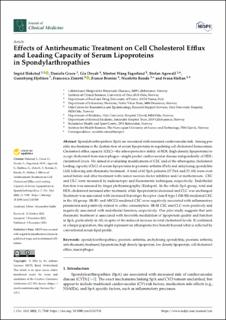| dc.contributor.author | Hokstad, Ingrid | |
| dc.contributor.author | Greco, Daniela | |
| dc.contributor.author | Deyab, Gia | |
| dc.contributor.author | Fagerland, Morten | |
| dc.contributor.author | Agewall, Stefan | |
| dc.contributor.author | Hjeltnes, Gunnbjørg | |
| dc.contributor.author | Zimetti, Francesca | |
| dc.contributor.author | Bernini, Franco | |
| dc.contributor.author | Ronda, Nicoletta | |
| dc.contributor.author | Hollan, Ivana | |
| dc.date.accessioned | 2023-01-10T09:25:53Z | |
| dc.date.available | 2023-01-10T09:25:53Z | |
| dc.date.created | 2023-01-06T12:40:09Z | |
| dc.date.issued | 2022 | |
| dc.identifier.citation | Journal of Clinical Medicine. 2022, 11 (24), . | en_US |
| dc.identifier.issn | 2077-0383 | |
| dc.identifier.uri | https://hdl.handle.net/11250/3042210 | |
| dc.description.abstract | Spondyloarthropathies (SpA) are associated with increased cardiovascular risk. Among possible mechanisms is the dysfunction of serum lipoproteins in regulating cell cholesterol homeostasis. Cholesterol efflux capacity (CEC)—the atheroprotective ability of HDL (high density lipoproteins) to accept cholesterol from macrophages—might predict cardiovascular disease independently of HDL-cholesterol levels. We aimed at evaluating modifications of CEC and of the atherogenic cholesterol loading capacity (CLC) of serum lipoproteins in psoriatic arthritis (PsA) and ankylosing spondylitis (AS) following anti-rheumatic treatment. A total of 62 SpA patients (37 PsA and 25 AS) were evaluated before and after treatment with tumor necrosis factor inhibitor and/or methotrexate. CEC and CLC were measured by radioisotopic and fluorometric techniques, respectively. Endothelial function was assessed by finger plethysmography (Endopat). In the whole SpA group, total and HDL-cholesterol increased after treatment, while lipoprotein(a) decreased and CLC was unchanged. Treatment was associated with increased Scavenger Receptor class B type I (SR-BI)-mediated CEC in the AS group. SR-BI- and ABCG1-mediated CEC were negatively associated with inflammatory parameters and positively related to coffee consumption. SR-BI CEC and CLC were positively and negatively associated with endothelial function, respectively. Our pilot study suggests that anti-rheumatic treatment is associated with favorable modulation of lipoprotein quality and function in SpA, particularly in AS, in spite of the induced increase in total cholesterol levels. If confirmed in a larger population, this might represent an atheroprotective benefit beyond what is reflected by conventional serum lipid profile. | en_US |
| dc.language.iso | eng | en_US |
| dc.publisher | MDPI | en_US |
| dc.rights | Navngivelse 4.0 Internasjonal | * |
| dc.rights.uri | http://creativecommons.org/licenses/by/4.0/deed.no | * |
| dc.title | Effects of Antirheumatic Treatment on Cell Cholesterol Efflux and Loading Capacity of Serum Lipoproteins in Spondylarthropathies | en_US |
| dc.title.alternative | Effects of Antirheumatic Treatment on Cell Cholesterol Efflux and Loading Capacity of Serum Lipoproteins in Spondylarthropathies | en_US |
| dc.type | Peer reviewed | en_US |
| dc.type | Journal article | en_US |
| dc.description.version | publishedVersion | en_US |
| dc.source.pagenumber | 0 | en_US |
| dc.source.volume | 11 | en_US |
| dc.source.journal | Journal of Clinical Medicine | en_US |
| dc.source.issue | 24 | en_US |
| dc.identifier.doi | 10.3390/jcm11247330 | |
| dc.identifier.cristin | 2102009 | |
| cristin.ispublished | true | |
| cristin.fulltext | original | |
| cristin.qualitycode | 1 | |

